
Quantum Efficiency Tester
PL/EL Integrated System
PV-Reflectumeter
3D Confocal Microscope
In-Line Four Point Probe Tester
Four Point Probe Tester
In-Line Thin Film Thickness Tester
Raman Spectrometer
FTIR Spectrometer
Spectrophotometer
Automatic Spectroscopic Ellipsometer
Contact Resistance Tester
Ultra depth of field 3D microscope
Auto Visual Tester
VMM PV Vision Measuring Machine
Solar Cell Horizontal Tensile Tester
Steady State Solar Simulator for Solar Cell
Solar Cell UV Aging Test Chamber
Solar Cell Comprehensive Tensile Tester
Visual Inspection Tester
Wet Leakage Current Tester
PV Module EL Tester
PV Module UV Preconditioning Chamber
Steady State Solar Simulator for PV Module
Current Continuous Monitor
Potential Induced Degradation Test
Bypass Diode Tester
LeTID Test System
Reverse Current Overload Tester
Impulse Voltage Tester
Hipot Insulation Tester
Ground Continuity Tester
Hipot Insulation Ground Tester
Damp Heat Test Chamber
Humidity Freeze Test
Thermal Cycle Test Chamber
Dynamic Mechanical Load Tester
Static Mechanical Load Tester
Hail Impact Tester
Robustness of Termination Tester
Module Breakage Tester
Cut Susceptibility Tester
Peel Shear Strength Tester
Universal Testing Machine (Single-arm)
Universal Testing Machine (Double-arm)
Glass Transmittance Tester
Acetic Acid Test Chamber
EVA Degree of Crosslinking Test System
Junction Box Comprehensive Tester
Drop ball tester
Semi-automatic scanning four-probe tester
Stylus Profilometer
Maximum Power Point Tracker
Perovskite Glass Transmittance Tester
Perovskite P1 Laser Scribing Multifunctional Testing Machine
Perovskite Online PL Tester
Perovskite Online Sheet Resistance Tester
Online Perovskite Film Thickness Tester
Perovskite Process Inspection Workstation
Portable IV Curve Tester
Portable EL Tester
Portable Thermal Imaging Tester
Solar Module Multi-Channel Testing System
PV Inverter Power Quality Tester
Drone EL Tester
IV Tester
IVEL Cell Sorting Machine
Performance Evaluation of Transparent Backplane Assemblies Extended PID Stress Testing
Date : 2024-05-06Views : 170
Photovoltaic modules play a vital role in the generation of renewable energy. However, over time, PV modules can experience performance degradation due to various factors, one of which is Potential Induced Degradation (PID). In order to ensure the life and efficiency of the photovoltaic system, Potential Potential Induced Degradation (PID) Tester from Millennial Solar came into being. This article will deeply explore the Potential Induced Degradation (PID) performance evaluation of the transparent backsheet of the photovoltaic module and introduce its importance.
PID performance evaluation of transparent backplane
Transparent backsheets are currently a viable alternative to glass when building bifacial modules, with their main advantages being lower cost than glass, significantly lower weight, better transparency and better protection of the module from hail. In addition, because it does not contain sodium, the transparent backplane can also reduce the occurrence of PID and reduce the risk of PID on the back of the cell. The experiment examined the stability of photovoltaic modules constructed with transparent backsheets by exposing them to extended potential-induced decay (PID) stress.
The photovoltaic module used in the test is a P-PERC glass backsheet module, and its main properties are listed in the table below.

Test process
Five modules (one set of reference module, one set of 0V polarized module Mod1, one set of +1500V polarized module Mod2, and two sets of -1500V polarized module) were pretreated by current injection within 486 hours at 75°C. module Mod3&4), conduct current-voltage measurement control every 162 hours, and avoid light-induced degradation (LID) and light and high temperature-induced degradation (LeTID) during the test phase.
PID testing per IEC 61215 standard (MQT 21) at 85°C, 85% RH for up to 576 hours instead of the 96 hours required in the standard (voltage monitoring every 96 hours or 192 hours). Use a cutting wheel to cut two complete samples on the -1500V polarization module, and then use a diamond wire saw to cut one sample into small pieces of 1 cm × 1 cm.
Finally, the encapsulated samples were cut out and photoluminescence (PL) measurements were performed using BT imaging and finally transmission electron microscopy (TEM) measurements.
Test Results
Current-Voltage (I-V) Figures 1 and 2 plot the performance evolution of the module front and back through PID testing respectively.
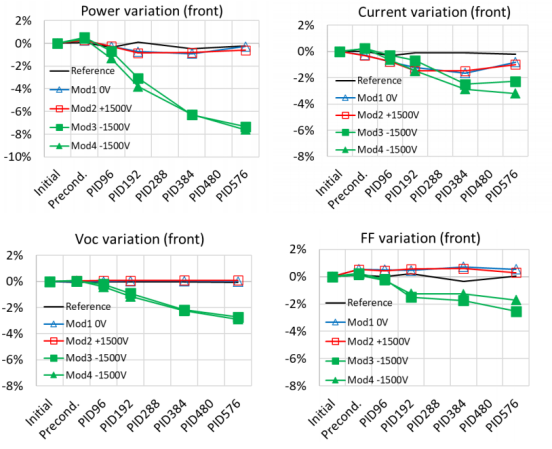
Figure 1. Performance evolution of module front in extended PID test
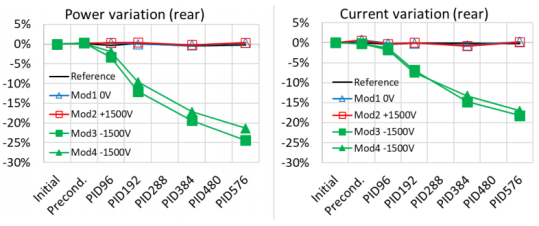
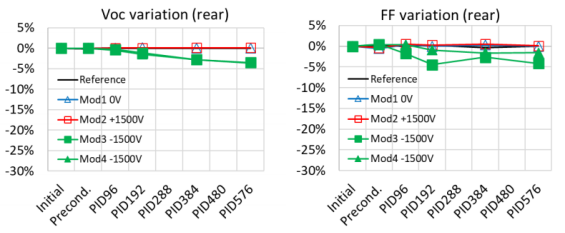
Figure 2. Performance evolution on the back of the module during extended PID testing
As shown in Figure 1, the module performance on the front side is not affected by the applied positive or neutral voltage. After the test, all electrical parameters of the module are similar to those of the untested reference module. In contrast, applying a negative voltage, after 576 hours of PID, the power on the front dropped by nearly 8%, the performance on the back dropped three times more severely (25%), and the current varied significantly, as shown in Figure 2.
Electroluminescence and Photoluminescence Characterization
To better understand the reasons for the performance degradation, EL and PL detection was performed on module Mod3. The EL imaging of module Mod3 and the PL imaging of the cut sample are shown in the figure below.
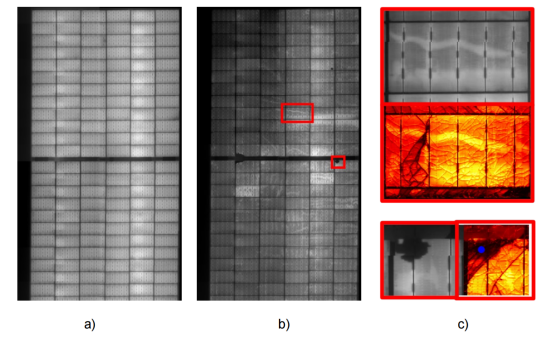
a) EL imaging of Mod3 after pretreatment; b) EL imaging after 576 hours of PID testing; c) Top: EL and PL imaging after magnification; Bottom: EL and PL imaging in dark areas
Since the PL measurement uses cells cut out of the module, glass cracks can be seen in the picture. EL imaging shows a general decrease in signal and the appearance of some dark areas, with some "light trails" also visible on most cells with locally higher EL intensity. These dark areas and light trails were also confirmed by PL imaging and pointed to potential local passivation changes.
A double-sided module with a transparent backsheet was subjected to extended PID stress testing, and current-voltage, EL and PL measurements showed the presence of two types of PID effects in the module: PID potential type (PID-p) and corrosion type (PID-c). The type of shunting of PID-s is generally associated with the migration of sodium ions from the glass into the cell, and the current-voltage changes did not show any significant Voc fill factor drop. Even if no direct evidence is observed using TEM measurements, the observed localized depassivation may be related to PID-c.
Potential Induced Degradation Tester
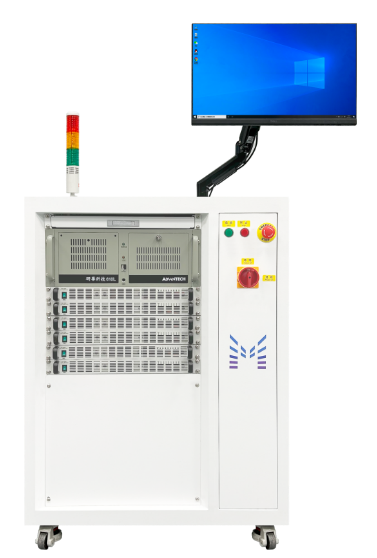
E-mail: market@millennialsolar.com
Introduce:
Long-term current leakage will cause changes in the state of the cell carriers and depletion layer, corrosion of the contact resistance in the circuit, and electrochemical corrosion of the packaging materials.
This results in cell power attenuation, increased series resistance, reduced light transmittance, delamination and other phenomena that affect the long-term power generation and life of the module.
Fulfill the standard:
Meets the MQT21 clauses in the IEC61215 standard and the IEC62804 standard
Features:
•The frame end of the module is grounded, which not only simulates the actual situation, but also prevents potential dangers caused by high voltage on the frame;
•Using a 2-wire test method, the positive and negative electrodes are short-circuited and connected to the positive electrode, and the negative electrode is connected to the equipotential hole of the frame;
•Each channel is independent of each other, and the voltage size, polarity and time of multiple channels can be set independently;
•Multiple voltages, leakage current, and insulation resistance are displayed simultaneously;
•Real-time monitoring of voltage, leakage current, and insulation resistance curves;
In the rapidly growing solar industry, the reliability and efficiency of photovoltaic systems are critical. Potential Induced Degradation Tester from Millennial Solar follows IEC standards and helps manufacturers maintain high standards of quality and performance in their projects, playing a vital role in ensuring that modules reach their full potential and deliver expected performance over the long term, serving global customers. Contributing to the growth of renewable energy.

































































